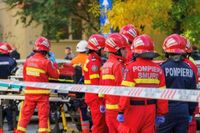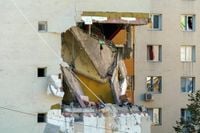On the morning of October 17, 2025, a powerful explosion ripped through an eight-story apartment building in Bucharest, Romania’s capital, leaving a scene of devastation and heartbreak. The blast, which authorities believe was most likely caused by an accidental gas leak, killed three people and injured at least 14 others, including a 17-year-old girl who remains in critical condition. It was a tragedy that shook the city and raised urgent questions about safety and oversight in residential buildings.
The explosion struck the fifth and sixth floors of the residential block on Calea Rahovei in Bucharest’s Sector 5, a peripheral district of the city. According to the capital’s Inspectorate for Emergency Situations, the force of the blast was so intense that it completely collapsed two floors and tore apart the facades of the upper stories. Video footage released by emergency services showed mangled corners of the building, with windows blown out in neighboring apartments and debris scattered across the street below. The destruction wasn’t limited to the building itself—the blast also broke windows at a nearby high school, and detached construction elements from the facade of another nearby apartment block were observed, as reported by emergency authorities and Hotnews.ro.
More than a dozen emergency vehicles, including 11 fire engines and four mobile intensive care units, rushed to the scene. Firefighters ordered the evacuation of all 108 apartments in the building, fearing further collapse. Teams worked urgently to search for anyone trapped in the rubble, and all residents were evacuated as a safety precaution. The Ministry of Health reported that victims suffered from polytrauma and burns, with at least 13 people transported to hospitals across Bucharest. Three of those hospitalized had severe burns and, according to the Health Ministry, were slated to be transferred abroad for specialized treatment once their conditions stabilized.
One particularly harrowing discovery came when rescue teams found a victim dead under a concrete slab on the building’s sixth floor. The human toll was immediate and profound. Among the injured, a 17-year-old girl was reported to be in critical condition, highlighting the indiscriminate nature of the disaster.
Authorities wasted no time in addressing the immediate risks. The gas supply in the area had already been shut off the previous day, October 16, after residents reported smelling gas—a decision that, in hindsight, may have prevented even greater loss of life. However, new reports of gas leaks were received on the morning of October 17, just moments before the explosion occurred, according to statements from local officials and news website Biziday. As a further safety measure, all students and teachers at the nearby Dimitrie Bolintineanu High School were evacuated, a move confirmed by Bucharest’s School Inspectorate.
Romania’s Prime Minister Ilie Bolojan addressed the nation via public broadcaster RRA, describing the extent of the damage and the government’s response. “More than 400 residents have been affected, but all have been provided with temporary accommodation in safe conditions,” Bolojan stated. The Prime Minister also noted that the building was so heavily damaged it would likely have to be demolished—a grim prospect for the families who called it home.
The aftermath was a scene of chaos and sorrow. Rubble littered the street, and the facades of the upper floors were left gaping open to the elements. Neighbors and passersby watched in shock as emergency crews worked tirelessly, some clinging to the hope that more survivors might be found. The blast’s impact extended beyond the immediate area, with reports of broken windows and structural damage to nearby buildings. As one witness described to local media, “It was a horror.”
Authorities have launched a full investigation into the cause of the explosion, but early indications point to a tragic sequence of events involving gas leaks and possibly faulty infrastructure. The gas supply had been stopped on Thursday, October 16, after multiple safety complaints, and yet, fresh reports of leaks came in just before the explosion. This timeline of warnings and actions has prompted questions about whether more could have been done to prevent the disaster, and whether systemic issues in building maintenance and gas safety protocols need to be addressed.
Local media, including Reuters and Hotnews.ro, reported that the explosion not only collapsed two floors but also affected apartments below, compounding the destruction. Firefighters and search teams continued their work throughout the day, combing through debris for anyone who might still be trapped. The urgency and scale of the response underscored the gravity of the situation.
In the immediate wake of the explosion, the community rallied to support those displaced. According to Prime Minister Bolojan, temporary accommodations were arranged for all affected residents, ensuring they had safe shelter as authorities assessed the structural integrity of the building and surrounding area. The psychological impact, however, is likely to linger far longer. For many, the trauma of losing their homes, and for some, loved ones, will not easily fade.
As the dust settles, the focus is turning to the broader implications of the tragedy. Romania, like many countries in Eastern Europe, has a significant stock of older apartment buildings, many of which were constructed during the communist era. Concerns about aging infrastructure and the adequacy of maintenance have surfaced repeatedly in recent years, and this latest disaster has reignited calls for stricter safety regulations and more proactive inspections. The fact that gas leaks had been reported and the supply shut off, only for new leaks to be detected hours before the explosion, is certain to be a focal point of the investigation.
In the end, the Bucharest apartment explosion stands as a stark reminder of the importance of vigilance, timely action, and robust public safety measures. The loss of three lives, the injuries to at least 14 others, and the displacement of hundreds will weigh heavily on the city for some time. As the investigation continues and the community begins the slow process of recovery, many are left asking: could this tragedy have been prevented, and what must change to ensure it never happens again?
For now, the people of Bucharest mourn, support one another, and wait for answers—hoping that from this devastation, lessons will be learned that might spare others in the future.

